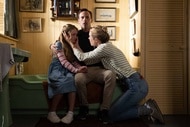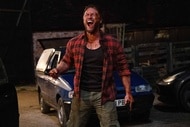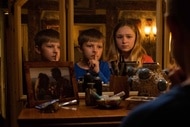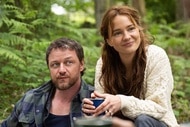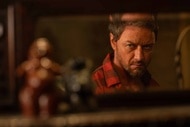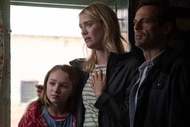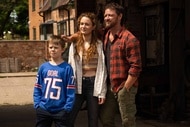'Make it a little more Ridley Scott': How Snowpiercer's 1,001-car train got built IRL

In the cold, post-apocalyptic world of Snowpiercer, the only humans left alive survive because of the titular train, a 1,001-car monster created by the mysterious Mr. Wilfred. In the real world, though, somebody had to design Snowpiercer — and make it so they could actually film a TV show inside such seemingly cramped sets.
"To be honest with you, there are a couple of design issues and challenges about the train," production designer Barry Robison tells SYFY WIRE. "The train cars are no wider than 12 feet and our longest car was 60 feet long, but for the most part, they were 40 feet long. So, for any designer going into a project like this, it's an abstract challenge in the nth degree."
Robison also had to make the train visually interesting — it's a dystopian society on rails, not an Amtrak, after all. Rather than imitate the train as it appeared in Bong Joon Ho's film adaptation, Robison decided to go back to the original French graphic novel that both the film and the new TNT show are based on.
"The graphic novel was really robust in its stylization," Robison says. "It didn't feel sci-fi. It didn't feel steampunk-ish. It just had this really strange other world-like quality about it. And that's what I wanted for the design. I wanted it to be strong, robust, and strange."
Robison revealed more of Snowpiercer's secrets in his interview with SYFY WIRE.
Was it tricky to design sets that were both realistically cramped, but also that it was possible to actually film a TV show inside of?
In one word: Yes. [Laughs.] It was really a challenge. We had these cars that the effects department had built by the time I had arrived on location in the studio. They were semi-trailers that had been adjusted for the stage. Our base platform was there. We had four soundstages and there were probably between four and six cars per soundstage, creating the 1,001 train cars. We left them on the wheels of the semi-trailers so that they constantly moved and shifted on stage. The walls of each car were built into panels that could be dropped so that cameras could get inside the train.
Is the design of the train functional? Are you aware of where the main path through the cars is or did you ensuring that everything needs to fit in the train fits in the train? Or do you take some creative liberties for the sake of making a more exciting set?
In my first week, I really felt that it was necessary to map out the train — all 1,001 cars. And I've got to tell you, it was really fun. It was a very long map in 16-inch to one-foot scale. I mean, it was forever long, because the train is over 10 miles long. I worked with [executive producer James Hawes] and [Showrunner Graeme Manson] on how many tail cars, how many border crossing cars, how many third-class cars, how many second-class, how many utility cars for waste or food. We were really trying to be accurate and real about the train because Graeme and James and TNT wanted the technology to be rooted in today. This could happen three years from now as opposed to way in the future. So what we're dealing with is technology that we know of today within those cars. We tried to keep it as real as possible. And yes, we did have to take license on a number of occasions, but not so much that I think that the audience wouldn't believe that we were being true to the train.
Can you talk a little bit about your design philosophy when creating the distinction between First Class cars or Tail cars? How does the look of the train change as we move up Snowpiercer?
The overriding concept between First and the Tail is light. In the Tail, it's a windowless, dark environment. Once you get into Third Class, we start introducing lights. I want you to think of it almost like a ship — an ocean liner. If you're lower class or are in the sub part of the ship, it's windowless. You go to your next level, maybe you'll have the smallest of windows or portholes, and larger windows in second and obviously into First Class. And along with that a change of texture and materials and that was really, super important to show class distinction as well.
In the Tail section, it's dark metal, grunge. Third Class has sort of grim colors, no metallics. Everything's a painted surface. Second introduces metallic finishes and better finishes, all staying within the train vernacular. In First Class, the finishes are luxurious, high-end, gloss lacquers, rich carpeting. One thing that TNT was adamant about was they did not want chrome finishes anywhere on the train. I thought that was a great call on their part, and I talked them into using copper. I wanted to use copper because copper is an old material and it can change depending upon how the copper is used. In First Class, it was high, high, high polish.
When I interviewed Daveed Diggs, he had a lot of praise for the sets and he said he was especially excited for fans to notice all the little details you'd packed every car with. Are there any details or Easter eggs that you were especially proud of?
[I'm proud of] the first-class dining room. I said, well, there's gotta be a strata structure even in the first class. So you'll notice that there are three tiers in the car. Up by the fireplace — that would be Wilfred's domain. Should he ever come in contact with the first-class passengers, he would be able to sit up there and look down and sort of lord over everyone.
"The Chains" was an interesting car. Graham had written this section of the train as a place where artists and young people could get together and live communally. Originally, it was a normal train car. And I said, "Hey, I've got this great idea. As the train's moving after all these years, foodstuffs are being used up and now there are empty cars. Why not have these young people go in and sort of take them over as their space? They've cut holes in the different containers and they put in ladders." It's sort of a strange and cool community element. Over the years, things are glued together and nothing is perfect. You can sort of see that in the engine as well, where monitors have been sort of put up on walls where they wouldn't originally be.
We did not want a perfect environment because that's true sci-fi, where it's so perfect and clean. I kept saying "we've got to make it a little more Ridley Scott." The thing that Ridley Scott and his designer Arthur Max did so brilliantly is to make their environments look lived-in. There may have been a high-tech gloss finish at one time, but not anymore.










